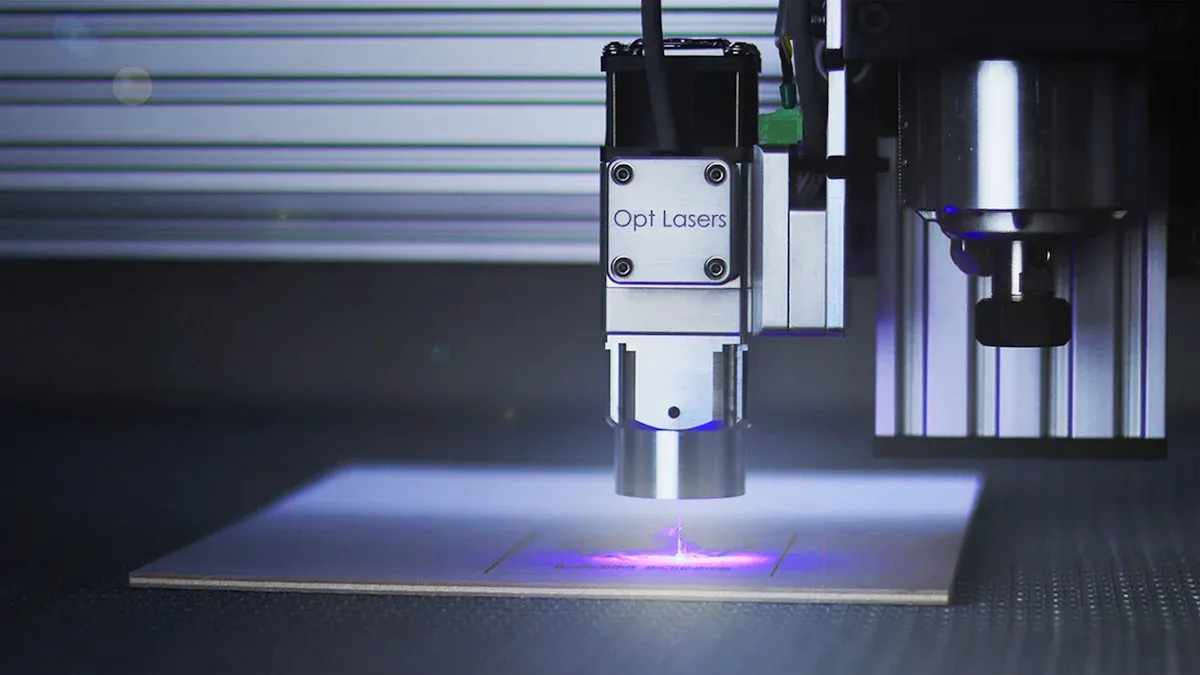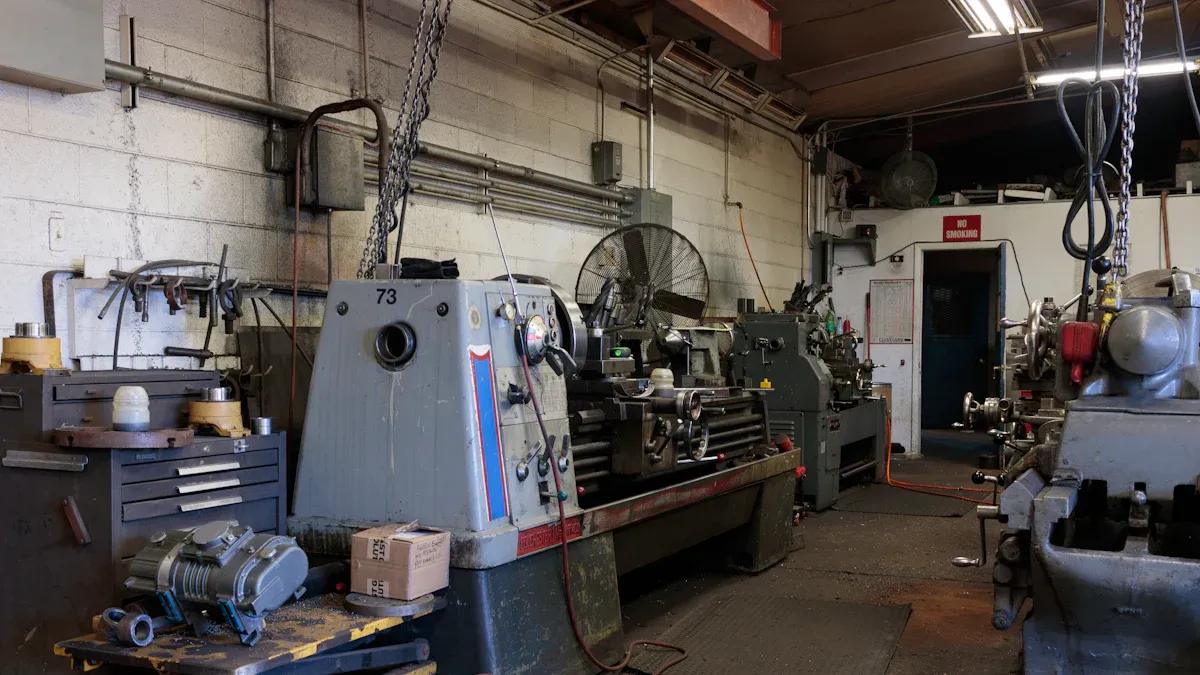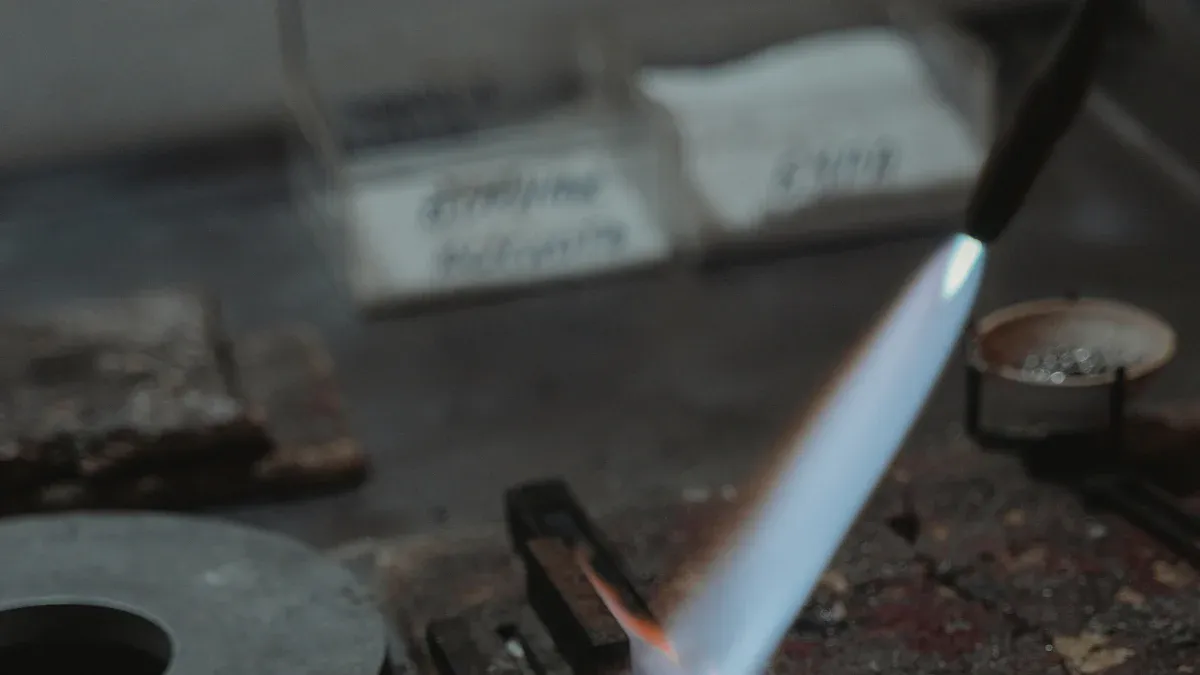
Picture this: your production line grinds to a halt, and every passing minute is like watching money slip through your fingers. Equipment downtime isn’t just frustrating—it’s expensive. For example, manufacturers in the automotive sector can lose up to $22,000 every minute their operations stop. On average, plants experience 20 downtime incidents and lose 25 hours of production every month. These disruptions don’t just drain profits; they can derail continuity in critical projects and damage customer trust.
That’s where emergency mold repair comes in. This quick-response service tackles urgent issues with your molds, helping you minimize downtime and keep your operations running smoothly. Whether it’s a sudden breakdown or a pressing production challenge, emergency mold repair ensures you’re back on track fast.
Downtime can hit your wallet hard. When your equipment stops working, your production halts, and so does your revenue. For example, Fortune Global 500 manufacturers lose an estimated $864 billion annually due to unplanned downtime. That’s about 8% of their total revenue! Even smaller companies feel the pinch, with some losing over $100,000 for every hour their operations are down.
The costs don’t stop there. Regulatory fines, missed deadlines, and even stock price drops can pile on. Here’s a quick breakdown of how downtime costs stack up:
| Cost Type | Annual Cost (in millions) | Recovery Time (days) |
|---|---|---|
| Revenue Loss | $49 | 75 |
| Regulatory Fines | $22 | N/A |
| Missed SLA Penalties | $16 | N/A |
| Stock Price Drop | N/A | 79 |
| Ransomware and Extortion Payouts | $19 | N/A |
| Average Cost of Downtime (US) | $256 | N/A |
| Average Cost of Downtime (Europe) | $198 | N/A |
| Average Cost of Downtime (APAC) | $187 | N/A |
When you think about it, downtime isn’t just a temporary inconvenience—it’s a financial drain. Investing in emergency services like mold repair can help you avoid these staggering losses and keep your business running smoothly.
Downtime doesn’t just cost money; it disrupts your entire workflow. Imagine your production line grinding to a halt. Machines sit idle, employees wait around, and deadlines slip further away. This ripple effect can throw off your entire schedule.
Tracking metrics like Overall Equipment Effectiveness (OEE) can help you understand how downtime impacts productivity. OEE measures how efficiently your equipment runs, and downtime directly affects its availability. Here’s why this matters:
By addressing downtime quickly with emergency mold repair services, you can minimize these disruptions and keep your operations on track.
Your customers expect reliability. When downtime strikes, it can lead to delays, missed deadlines, and frustrated clients. Over time, these issues can erode trust and damage your reputation.
For example, if a critical order is delayed because of equipment downtime, your customer might start looking for a more reliable supplier. Negative experiences like these can have long-lasting effects, especially in industries where trust and consistency are key.
Tip: Quick response times and reliable emergency services can help you maintain your reputation and keep your customers happy.
In today’s competitive market, your reputation is everything. By minimizing downtime, you show your customers that they can count on you, even when challenges arise.

Emergency mold repair is a specialized service designed to address urgent issues with your molds, especially when production downtime is at stake. Think of it as a lifeline for your manufacturing process. When your injection mold breaks or malfunctions, emergency assistance ensures quick fixes to get your operations back on track. These services focus on rapid response, minimizing delays, and keeping your production line running smoothly.
The process typically starts with an assessment to identify the problem. Once the issue is pinpointed, technicians work to repair or replace the damaged components. Whether it’s a minor adjustment or a major overhaul, emergency mold repair services are tailored to meet your specific needs. This approach not only resolves immediate problems but also prevents further disruptions.
Emergency mold repairs cover a wide range of services to tackle different challenges. Here’s what you can expect:
These services are available 24/7, ensuring you get the help you need when you need it most. With in-house fleets for delivery and emergency repair capabilities, service providers can quickly respond to your requests. This reduces waiting time and keeps your production schedule intact.
| Feature | Benefit | Impact on Downtime |
|---|---|---|
| 24/7 service availability | Immediate response to repair needs | Minimizes downtime |
| In-house fleet for delivery | Quick pickup and delivery of tools | Reduces waiting time for repairs |
| Emergency repair capabilities | Fast resolution of mold issues | Keeps production running smoothly |
| Preventive maintenance programs | Regular inspections to prevent breakdowns | Decreases unplanned downtime |
When your production line faces unexpected issues, emergency mold repair becomes a game-changer. Quick response times mean you can fix equipment promptly and get back to work without major delays. This protects your project timelines and ensures smooth operations.
On-site repairs are another advantage. Technicians can address problems directly at your facility, saving time and reducing costs. By resolving issues quickly, you maintain productivity and avoid the ripple effects of downtime. Plus, timely repairs help you meet deadlines, keeping your customers happy and your reputation intact.
Pro Tip: Regular preventive maintenance can save you from costly emergencies. Early detection of issues reduces repair costs and keeps your equipment in top shape.
Emergency mold repair isn’t just about fixing problems—it’s about keeping your business running efficiently, no matter what challenges arise.
When your production line comes to a halt, every second counts. Rapid turnaround mold repair ensures you get back to business quickly. This emergency service focuses on minimizing downtime by addressing mold issues with speed and precision.
Here’s how it works:
- Precision welding services restore worn mold components in record time.
- Laser welding brings damaged molds back to their original specifications.
- These techniques allow tools to return to production swiftly and cost-effectively.
This fast turnaround not only reduces molder downtime but also ensures the quick restoration of operations. By choosing a rapid response service, you can keep your production schedule on track and avoid costly delays.
Downtime can drain your budget faster than you think. Emergency mold repair helps you save money by reducing the time your equipment stays idle. Think about it—when your molds are repaired quickly, you avoid the ripple effects of halted production.
Here’s why this matters:
- You save on labor costs since employees won’t be waiting around for repairs.
- You avoid penalties for missed deadlines or late deliveries.
- You reduce the need for costly replacements by extending the life of your molds.
By investing in emergency services, you’re not just fixing a problem—you’re protecting your bottom line. The faster your molds are repaired, the less you lose in revenue and productivity.
Emergency mold repair doesn’t just solve immediate problems; it sets the stage for long-term success. When your molds are repaired efficiently, your entire production process benefits.
Take a look at some key benchmarks that improve with emergency mold repair:
| Benchmark | Improvement Description |
|---|---|
| Reduced response times | Emergency repairs can now be addressed almost immediately, minimizing safety risks. |
| Enhanced flexibility | Ability to handle multiple high-priority repairs simultaneously without bottlenecks. |
| Increased precision | Achieved highly accurate welds in previously difficult areas. |
| Faster turnaround times | Repairs that took days can now be completed in hours or minutes. |
| Improved confidence | Team's confidence in repair quality has significantly increased due to reliable performance. |
| Extended mold life | More targeted repairs have led to improved durability of molds post-repair. |
These improvements translate to smoother operations and higher customer satisfaction. With faster turnaround times and reduced downtime, you can meet deadlines more consistently and deliver quality products. Emergency mold repair isn’t just a quick fix—it’s a strategy for long-term efficiency.
When it comes to keeping your production line running smoothly, prevention is always better than cure. Addressing mold issues before they escalate can save you time, money, and stress. But how do you ensure your molds stay in top shape for the long haul? Let’s dive into some practical strategies.
Think of your molds as the backbone of your production process. Without them, everything grinds to a halt. Regular maintenance checks help you spot small problems before they turn into big ones. For example, inspecting for wear and tear or cleaning buildup from mold surfaces can prevent costly repairs later.
Tip: Schedule maintenance during planned downtime to avoid disrupting your workflow. A little planning goes a long way in keeping your operations efficient.
The materials you use for your molds play a huge role in their longevity. High-quality materials resist wear and damage better than cheaper alternatives. While the upfront cost might seem higher, the long-term savings are worth it. Durable molds mean fewer breakdowns and less need for emergency repairs.
A preventive maintenance program is like a health checkup for your molds. It includes regular inspections, cleaning, and minor repairs to keep everything running smoothly. These programs help you catch issues early, reducing the risk of unexpected downtime.
Here’s what a typical preventive maintenance schedule might look like:
| Maintenance Task | Frequency | Purpose |
|---|---|---|
| Surface Cleaning | Weekly | Removes buildup and ensures quality |
| Component Inspection | Monthly | Identifies wear and tear |
| Lubrication | Quarterly | Reduces friction and extends life |
| Full Mold Overhaul | Annually | Addresses hidden or major issues |
Your team plays a critical role in mold care. Training them to handle molds properly can prevent accidental damage. Teach them how to clean, store, and inspect molds. When everyone knows what to do, you reduce the chances of mishandling and extend the life of your equipment.
Modern technology offers tools that make mold maintenance easier. For instance, sensors can monitor mold performance and alert you to potential issues. These tools help you stay ahead of problems and avoid costly downtime.
Pro Tip: Pair technology with regular human inspections for the best results. Machines can’t catch everything, but they can make your job easier.
Even with the best prevention strategies, emergencies can still happen. That’s why it’s essential to have a trusted service provider on speed dial. They can step in when you need urgent repairs and help you get back on track quickly. Building a strong relationship with a reliable provider ensures you’re never caught off guard.
By following these steps, you can keep your molds in excellent condition and avoid unnecessary disruptions. Prevention isn’t just about saving money—it’s about protecting your reputation and ensuring your customers always receive high-quality products.
Strong partnerships with service providers can make all the difference when you face an unexpected breakdown. By building these relationships early, you ensure faster responses and better support during emergencies. Think of it as having a trusted friend you can call when things go wrong.
Here’s how forming partnerships can benefit your emergency field service needs:
- Collaborating with insurance companies speeds up claim processes by up to 70%.
- Partnering with local governments ensures you get priority service during community recovery efforts.
- Bundling services like mold remediation and debris removal attracts better contracts and competitive pricing.
- Maintaining open communication with service providers reduces delays and ensures smooth operations.
When you invest time in these relationships, you’re not just preparing for emergencies—you’re setting up a safety net for your production capabilities.
Not all emergency field service providers are created equal. Evaluating their capabilities ensures you choose the right partner for your needs. Start by comparing their services and performance metrics. Here’s a quick guide to help you assess them:
| Criteria | Description |
|---|---|
| Visual Inspection | Dust-free to a white glove standard |
| Total Fungal Material | Less than 2,000 spore count per cubic meter of air |
| Comparison Sample | Below 800 c/m3 or less than the make-up air source |
| Fungal Type Levels | Less than 100 c/m3 above outdoor sample levels |
| Aspergillus - Penicillium | Equal to or below 200 c/m3 |
| Target Spores | No observed spores during analysis |
By using these benchmarks, you can identify providers who meet your quality standards. Don’t forget to ask about their on-site equipment repair services. Providers with this capability can address issues directly at your facility, saving you time and money.
Emergencies are unpredictable, but you can prepare for them with a solid contingency plan. This plan acts as your roadmap during unexpected breakdowns, ensuring you stay on track. Here are some strategies to consider:
- Natural Disaster Contingency Plan: Identify potential risks, create evacuation procedures, and establish backup power sources. Build relationships with alternative suppliers to avoid disruptions.
- Supply Chain Disruption Plan: Diversify your suppliers, maintain safety stock, and develop alternative transportation routes. Regularly review and update your plan to stay prepared.
Having a contingency plan isn’t just about reacting to problems—it’s about staying proactive. When you’re ready for anything, you can handle emergencies with confidence and keep your production running smoothly.

Imagine this: a major automotive manufacturer faces a sudden mold failure during peak production. Every minute of downtime costs thousands of dollars. Instead of waiting for a standard repair, they call in an emergency mold repair service. Within hours, technicians arrive, assess the damage, and perform on-site repairs. The production line resumes the same day, saving the company from losing millions.
This example highlights how quick action can prevent prolonged downtime. By addressing the issue immediately, the manufacturer avoided delays, met their deadlines, and maintained customer trust. It’s a clear reminder of how emergency services can be a game-changer when time is critical.
Small businesses often operate on tight budgets. For them, every dollar counts. Let’s say a local toy manufacturer experiences a mold malfunction. Instead of replacing the mold entirely, they opt for a cost-effective repair solution. Services like Jobber offer affordable options with transparent pricing and user-friendly features.
Here’s a quick comparison of solutions:
| Solution | Price Rating | Usability Rating | Features Rating | Pros | Cons |
|---|---|---|---|---|---|
| Jobber | 4/5 | 4/5 | 3/5 | Immediate start-up, transparent pricing, user-friendly design | Limited restoration features, fewer integrations, shallow reporting |
| Next Gear Dash | N/A | N/A | N/A | Advanced features for complex workflows | Higher costs and steeper learning curve |
| Restoration Manager | N/A | N/A | N/A | Good balance between affordability and restoration capabilities | N/A |
By choosing a service like Jobber, the toy manufacturer repaired their mold quickly and stayed within budget. This approach not only saved money but also ensured their production line kept moving.
Sometimes, repairing a mold isn’t just about fixing a problem—it’s about improving efficiency. Take the case of a packaging company that refurbished their molds instead of replacing them. The repair included precision welding and surface refinishing, which restored the molds to like-new condition.
The results? Faster production cycles, reduced waste, and improved product quality. Refurbishing also extended the life of their molds, saving the company from future breakdowns. This proactive approach turned a potential setback into an opportunity for growth.
Tip: Refurbishing your molds can boost efficiency and save costs in the long run. It’s a smart move for any business looking to stay competitive.
Minimizing downtime is crucial for keeping your production line running smoothly and your business profitable. Emergency mold repair services play a vital role in achieving this by offering rapid solutions that save time and money. They help you maintain operational efficiency and meet deadlines without compromising quality.
Building relationships with trusted service providers ensures you're prepared for any unexpected challenges. Take the proactive step today to safeguard your production processes and keep your business ahead of the competition.
Most providers aim to respond within a few hours, depending on your location and the severity of the issue. Some offer 24/7 availability to ensure you get help when you need it most.
Start by researching local providers with good reviews. Ask for recommendations from industry peers. Look for certifications and experience in handling urgent repairs.
Costs vary based on the complexity of the repair. However, they’re often more affordable than prolonged downtime or replacing molds entirely. Many providers offer transparent pricing to help you budget effectively.
Yes! Many services include preventive maintenance as part of their offering. Regular inspections and minor fixes can extend mold life and reduce the risk of unexpected failures.
It helps to have basic information ready, like the type of mold, the issue, and your production schedule. This ensures technicians can address the problem quickly and efficiently.